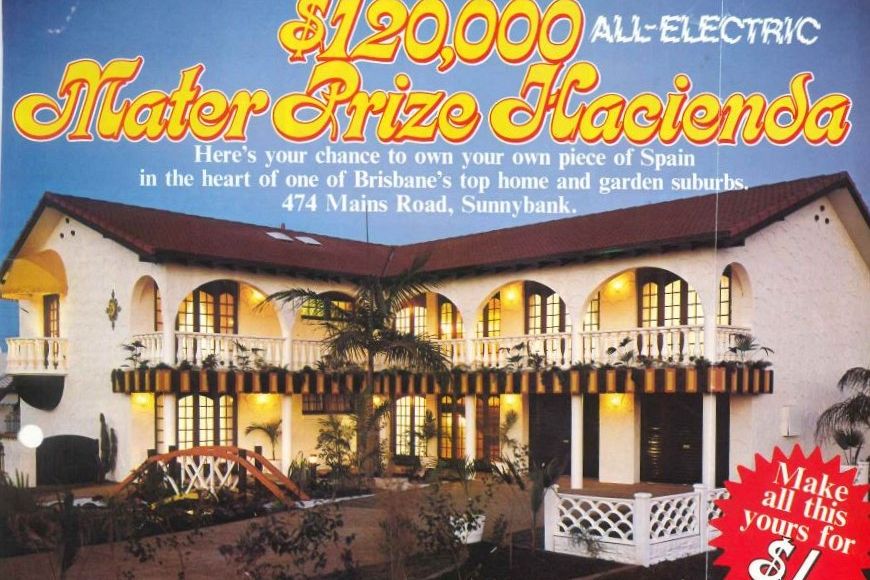
Property Management Experts
Servicing Brisbane for 10+ years with local knowledge and maximum returns!
About UsServicing Brisbane for 10+ years with local knowledge and maximum returns
About Us
Servicing Brisbane for 10+ years with local knowledge and maximum returns!
About Us
If you lived in Brisbane a few decades ago, finding home renovation inspiration required little more than a lottery ticket and a weekend road trip.
Queuing up to catch a glimpse inside a Mater Prize Home was a popular way to see how the other half lived and discover new design and architecture trends in the 1960s, '70s, and '80s.
Beyond the front door of each new home was a world of uber-modern architecture, expensive furniture, and perfectly appointed rooms protected from the public by little white chains.
Historian Marianne Taylor, who goes by the name The House Detective, said the Mater Sisters of Mercy raffled its first home in 1954 — a modest two-bedroom, fibro "shack" at Surfers Paradise valued at $7,800.
Not only was the lottery system a hugely successful fundraiser, Ms Taylor said its homes brought "revolutionary" new ideas about architecture and suburban living to Brisbane.
"By the third and fourth house they were absolutely cutting edge," she told ABC Radio Brisbane.
"If you think about the post-war suburbs in Brisbane, they were quite simple, quite plain.
"Then suddenly, like an alien spaceship, you'd have this incredible two-storey brick place.
"At the time no one had brick houses and they were absolutely striking inside and out."
Ensuites, open-plan living 'revolutionary'
Ms Taylor said architect John Dawson designed the first 100 homes between 1960 and 1975, and most of them were built by Les Smith.
While open-plan living is common in modern housing, Ms Taylor said it was a completely new concept for people living in traditional timber homes.
"If you think of a standard 1940s Brisbane house it tended to have a lot of little boxy rooms which harks back to traditional room design," she said.
"The open-plan nature of a lot of these homes would have been revolutionary."
Features like built-in wardrobes, air conditioning, and ensuite bathrooms were also "completely foreign" to most people living in Brisbane, and Ms Taylor said entire families would drive across town to see them.
"It seems a bit strange by today's standards but it was like the family outing," she said.
"You would pack up the kids in the car and drive out to one of these brand new suburbs that had the house to look through.
"The two things people remember are they always had plastic carpet protectors down on the floor … and if they visited as a child, they'd pick out the bedroom they wanted if they won it."
Fond memories of prize home tours
Shailer Park resident Heather Bensley remembers visiting prize homes after attending church on Sunday mornings.
She said it was a form of entertainment for her family who did not own a television set until the late 1960s.
"If you had one in your area you definitely went and had a look," she said.
"It was a must-do thing to see how the other half lived and what was state-of-the-art at the time."
Laundry chutes in high-set homes and carpets covering every inch of floor space stood out to her the most.
"In our home we just had wooden floors, and you had a hall runner and a big mat in the lounge room," Ms Bensley said.
"To have wall-to-wall carpet in those days was really up there."
Margate resident Aaron Busk lined up to see a new prize home with his mother and grandmother every two months as a child.
"Dad was in the army so we were in supplied housing and we didn’t really have much," he said.
"They had televisions, sometimes a pool, sometimes a pool table … stuff that we certainly had never seen.
"As a kid, it was just exciting to walk through this really grand house."
Lottery homes still stand out in the suburbs
Some of the most iconic Mater Prize Homes are still turning heads, including Tarragindi's retro jewel at 345 Marshall Road.
Its crowning feature is a unique roof that pitches down in the centre, making it appear like a giant butterfly about to take flight.
Ms Taylor said another stand-out was a grand, two-storey home on Mains Road in Sunnybank with four large columns framing the front entrance, affectionately known by some as the Graceland House.
"This stuff just wasn't seen in Brisbane. It must have been like something out of a Hollywood movie," she said.
Despite never buying a lottery ticket herself, Pam Hoile lived in a prize home on Ackama Street in Algester between 1986 and 1990.
She said the home's lofty cathedral ceilings, large glass windows overlooking parkland, and sunken "conversation pit" fireplace immediately appealed to her.
"A lot of the original furniture that had been part of the package was still in the home and was all colour coordinated," she said.
"It had an ensuite and, at the time, not a lot of homes had ensuites."
Ms Hoile said her home was one of three prize homes built side-by-side on Ackama Street in the early 1980s.
One had an "awesome" indoor swimming pool and the other was Japanese-inspired home with a stream running through the front yard.
Affordable dream funded medical treatments
When the lottery started, tickets cost as little as ten shillings — the cost of around ten loaves of bread in 1954.
"It was affordable for the average family. It wasn't completely out of their price range," Ms Taylor said.
"It actually funded the first Mater Mothers' Hospital and ensured people had good medical treatment.
"Women were still giving birth in private hospitals or at home so to have a good quality public hospital, particularly a maternity hospital, was incredible."
Mater Foundation is still building and raffling-off luxury homes around Queensland, however Ms Taylor said they do not have the same impact on the public as they once did.
"The early ones would have been completely striking to anyone who visited them," she said.
"They are definitely still stunning homes but I wouldn't say they are cutting edge anymore."
Ms Taylor said social media and popular home renovation programs on television now fulfilled our craving to see "how the other half live".
"This was the only chance to do that back then," she said.
https://www.abc.net.au/news/2022-02-20/brisbane-suburbs-revolutionary-lottery-homes/100799592